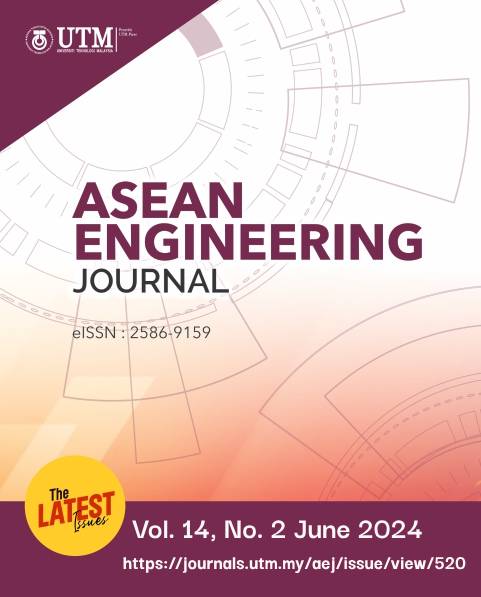OPTIMIZATION OF COMMERCIAL SILICA GEL REGENERATION VIA RESPONSE SURFACE METHODOLOGY
DOI:
https://doi.org/10.11113/aej.v14.20622Keywords:
Desiccant, optimization, silica gel, desiccant regeneration, response surface methodologyAbstract
Silica gel, a highly porous form of silicon dioxide, is widely used as a desiccant due to its hygroscopic properties and superior characteristics compared to organic materials. Although silica gel can be regenerated and reused, conventional methods often involve prolonged heating and limited ventilation, resulting in energy waste and reduced efficiency. To optimize the regeneration process, this paper presents an experimental approach to regenerate silica gel using response surface methodology (RSM). The study explores the influence of temperature, duration, and natural convection rate, which is regulated by adjusting the vent size of the oven. The results indicate that saturated silica gel at 98-100% equilibrium relative humidity (RH) can be effectively regenerated to nearly its dry weight by applying a temperature of 70°C for a duration of 10 minutes in a cubic oven measuring 15cm on each side, with an approximate vent area of 225cm2. Moreover, assigning different levels of importance to the influencing factors in the Design Expert software allows calibration of these factors to achieve the desired equilibrium RH.
References
Weintraub, S. 2002. Demystifying silica gel. 9: 169–194. Objects Specialty Group Postprints.
Hench, L. 1998. Sol-gel silica: properties, processing, and technology transfer. Westwood, N.J., U.S.A: Noyes Publications.
Feldman, M. and P. Desrochers. 2003. Research universities and local economic development: Lessons from the history of the Johns Hopkins University. Industry and Innovation, 10(1): 5–24. DOI: https://doi.org/10.1080/1366271032000068078.
Rambhad, K., P. Walke, and D. Tidke. 2016. Solid desiccant dehumidification and regeneration methods—A review. Renewable & Sustainable Energy Reviews, 59: 73–83. DOI: https://doi.org/10.1016/j.rser.2015.12.264.
Misha, S., S. Mat, M. Ruslan, and K. Sopian. 2012. Review of solid/liquid desiccant in the drying applications and its regeneration methods. Renewable & Sustainable Energy Reviews, 16(7): 4686–4707. DOI: https://doi.org/10.1016/j.rser.2012.04.041.
Rao, S. 2018. Adsorption. Self-assembly processes at interfaces: multiscale phenomena, 21: 252-253. DOI: https://doi.org/10.1016/B978-0-12-801970-2.00005-7.
Goldberg, L. and S. Weintraub. 2001. Regulations change for cobalt indicating silica gel. AIC News, 26(1): 14.
Yadav, A., and V. Bajpai. 2012. Experimental comparison of various solid desiccants for regeneration by evacuated solar air collector and air dehumidification. Drying Technology, 30(5): 516–525. DO: https://doi.org/10.1080/07373937.2011.647997.
Pramuang, S. and R. Exell. 2007. The regeneration of silica gel desiccant by air from a solar heater with a compound parabolic concentrator. Renewable Energy, 32(1): 173–182. DOI: https://doi.org/10.1016/j.renene.2006.02.009.
Yao, Y., W. Zhang, and B. He. 2011. Investigation on the kinetic models for the regeneration of silica gel by hot air combined with power ultrasonic. Energy Conversion and Management, 52(11): 3319–3326. DOI: https://doi.org/10.1016/j.enconman.2011.06.002.
Singh, S. and P. Singh. 1998. Regeneration of silica gel in multi-shelf regenerator. Renewable Energy, 13(1): 105–119. DOI: https://doi.org/10.1016/S0960-1481(97)00056-6.
Box, G. and K. Wilson. 1951. On the Experimental Attainment of Optimum Conditions. Journal of the Royal Statistical Society. Series B, Methodological, 13(1): 1–45. DOI: https://doi.org/10.1111/j.2517-6161.1951.tb00067.x.
Liu, M., B. Vinyard, J. Callahan, and M. Solomon. 2009. Accuracy, precision and response time of consumer bimetal and digital thermometers for cooked ground beef patties and chicken breasts. Journal of Muscle Foods, 20(2): 138–159. DOI: https://doi.org/10.1111/j.1745-4573.2009.00140.x.
Haloui, S. and A. El Moudden. 2020. An optimal prediction model’s credit risk: the implementation of the backward elimination and forward regression method. International Journal of Advanced Computer Science & Applications, 11(2): 457-467. DOI: https://doi.org/10.14569/IJACSA.2020.0110259.
Kozak, M. and H. Piepho. 2018. What’s normal anyway? Residual plots are more telling than significance tests when checking ANOVA assumptions. Journal of Agronomy and Crop Science, 204(1): 86–98. DOI: https://doi.org/10.1111/jac.12220.
Cimbala, J. 2008. Response surface methodology. https://www.me.psu.edu/cimbala/me345/Lectures/RSM.pdf. Retrieved November 28, 2022.
Prasad, A. and L. Yadav. 2018. Advanced Technology in Desiccant Wheel Air Conditioning System: A Review. IOP Conference Series: Materials Science and Engineering, 404(1): 12041–. DOI: https://doi.org/10.1088/1757-899X/404/1/012041.
Morais, E., R. Lattuada, G. Corrêa, R. Brambilla, and J. Dos Santos, 2020. Evaluating the effect of pharmaceuticals encapsulated in silica by the sol–gel method on algal growth inhibition. Journal of Sol-Gel Science and Technology, 94(3): 628–636. DOI: https://doi.org/10.1007/s10971-019-05194-x.
Simion, I. and P. Pascu. 2021. Microclimate control in museum display cases. Journal of Industrial Design and Engineering Graphics, 16(1): 9–12.
Thomson, G. 1986. The museum environment (2nd ed.). London: Butterworths, in association with the International Institute for Conservation of Historic and Artistic Works.
















